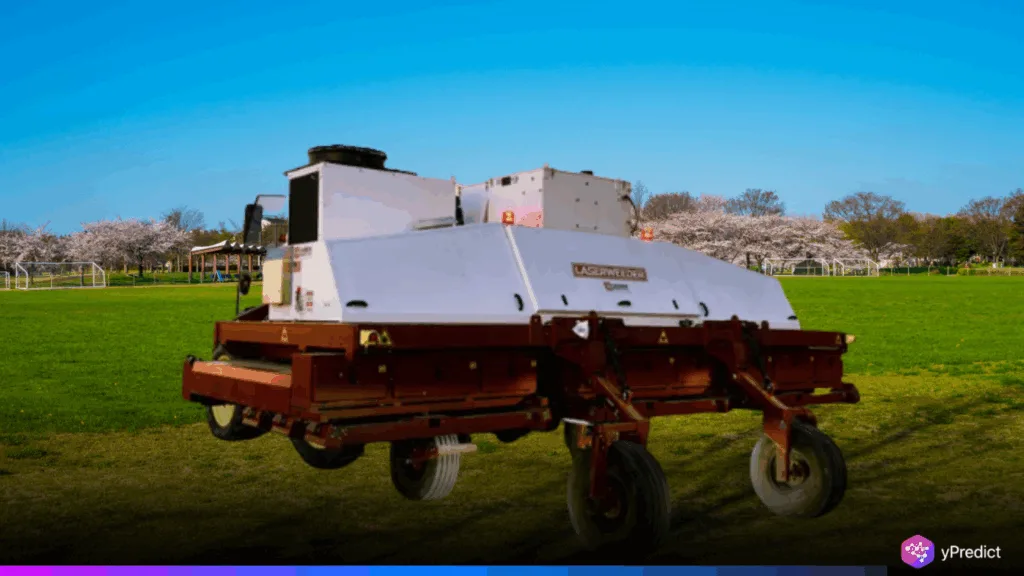
Weeds can be considered as one of the greatest problems of modern, contemporary crop farming, particularly specialty crop farming. Conventional methods are very labor-intensive or use chemical herbicides, the negative aspects of which are self-evident. Manual weeding is quite time-consuming, and the use of herbicides increases costs and environmental hazards. A new solution is LaserWeeder by Carbon Robotics. Powered by NVIDIA AI and with sophisticated computer vision, the machine kills weeds directly in the field with lasers. It is capable of destroying up to a maximum of 10,000 weeds within a time of one minute with accuracy. Integration of robot, imaging, and AI technologies makes the LaserWeeder a turning point in environmentally friendly farming, using no pesticides or chemicals.
How the LaserWeeder Works
The LaserWeeder is to automate and have precise control over weeds. The system mainly comprises 30 high-power diode lasers, 42 high-resolution cameras, and several LED light bars that scan crop rows in real time. The cameras obtain high-resolution photographs of plants, and the deep-learning algorithms can tell whether it is a crop or a weed. The LaserWeeder is strategically accurate in that lasers are only fired on weeds and not on any valuable crop.
Farmers access data generated by the system using an iPad Operator App and the Carbon Ops Center. These are weed counts, performance statistics, and crop health insights. An additional dedicated mobile companion app enables real-time field status monitoring and is easy to navigate, allowing for seamless operation monitoring even when out of the field.
The LaserWeeder utilizes more than 100 crop-specific AI models to identify weeds in all kinds of farming conditions. This makes it adaptable to various crops in specialties, such as carrots, onions, and greens. In contrast to spraying, this method kills weeds without the introduction of any chemicals or the need to spend extensive amounts of time relying on unwieldy workers. Simplifying the process of removing weeds without damaging crops, the LaserWeeder is one of the solutions that will decrease the level of labor required and promote the development of precision farming.
Impact on Modern Agriculture
An increase in the number of herbicide-resistant weeds has resulted in less effective and more An increase in traditional weed control. The farmers tend to invest a lot in chemicals. Substances and labor, and yet they get mixed results. The LaserWeeder is an alternative to the weeding task. Lasers can kill weeds instead of having to use chemicals, which reduces chemical consumption and environmental dangers. This aids in conservation of soil health, minimizing water pollution, and long-term sustainability.
LaserWeeder takes less time to complete compared to manual weed workers, which is tedious and costly. It has the capability of clearing fields at a rate inaccessible to workers, thus reducing the use of large seasonal labor pools. In crops, where accuracy is paramount, the possibility of carefully removing the weeds without damaging crops is a big factor that indicates the quality of the crop.
Other companies are also on the same track. An example is the See & Spray technology from John Deere, which incorporates AI and computer vision to deal with weeds with a high degree of accuracy. Both strategies identify how AI and robotics can transform food production, making it more efficient with reduced chemical dependency.
Though adoption can be costly, the LaserWeeder shows that agriculture is getting a new engine. The AI-enabled and robotic farms are more efficient at reconciling high production with sustainability and generating the long-term value of global food systems.
Conclusion
The LaserWeeder demonstrates how to address actual problems in farming through AI and robotics. Its ability to use lasers rather than chemistry ensures that it allows farmers to manage weeds sooner and helps to create healthy soils, clean water, and more sustainable agricultural systems. Although the high cost and intensity of training are a problem, it is an attractive option to specialty crop growers due to reduced labor, reduced cost of subscription to inputs, and increased profits. The modifying practices in farming with early detection tools could be a pertinent tool in current farming to save resources and feed a growing population.






